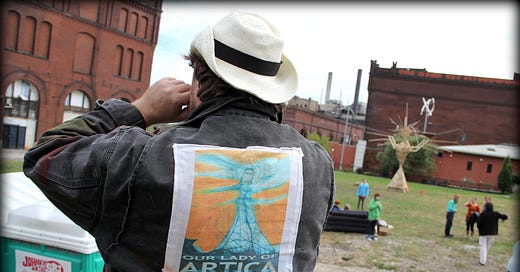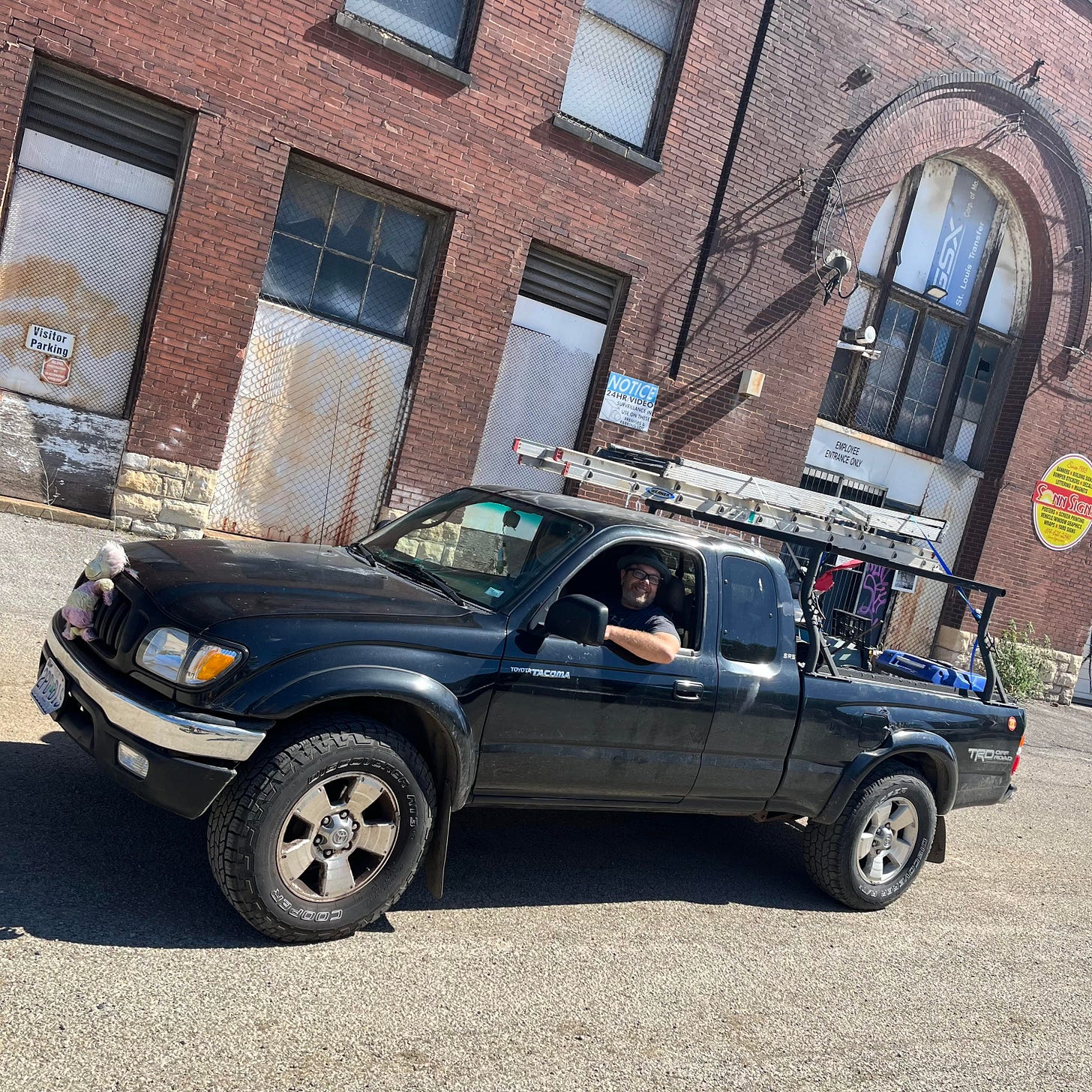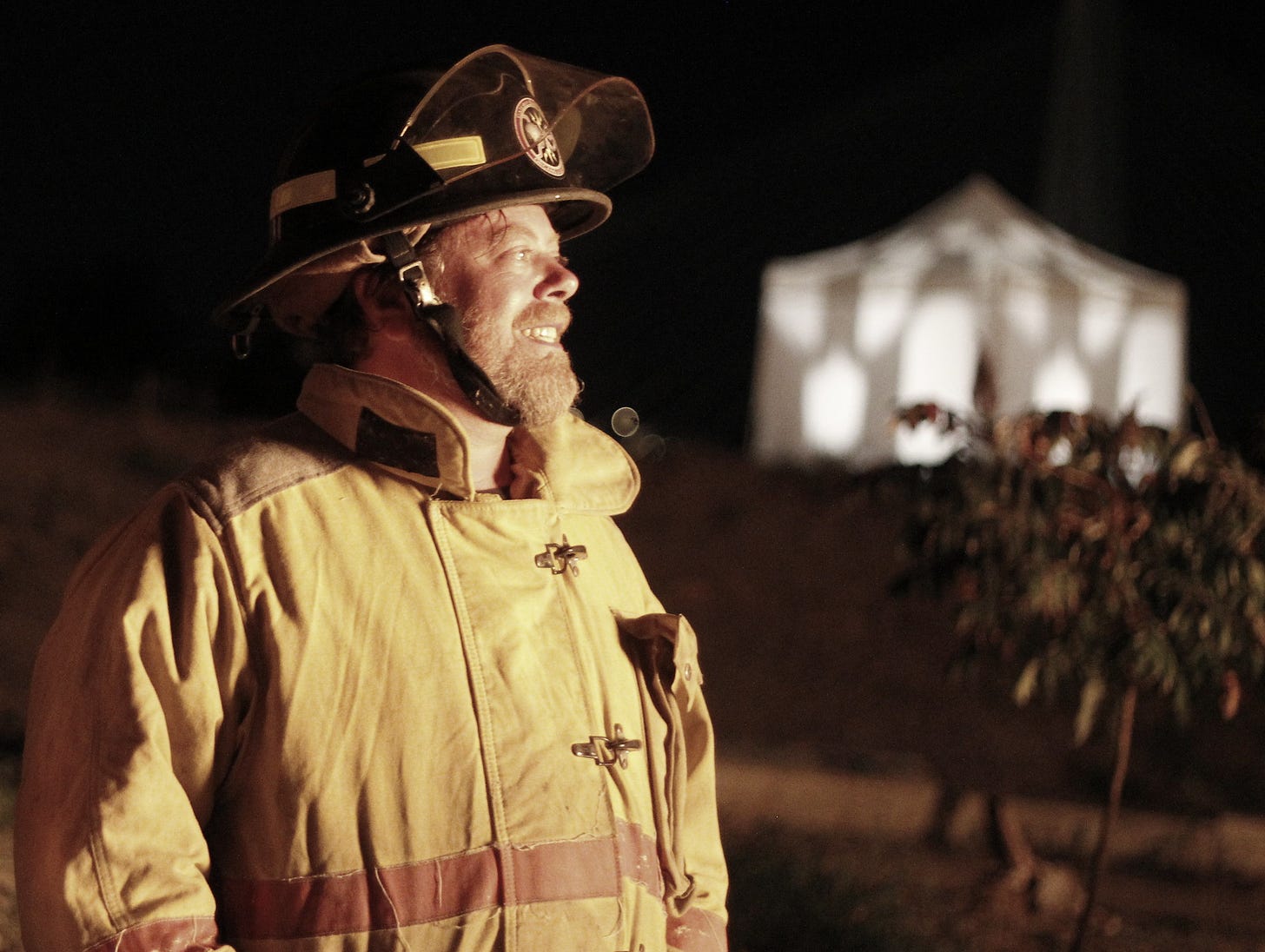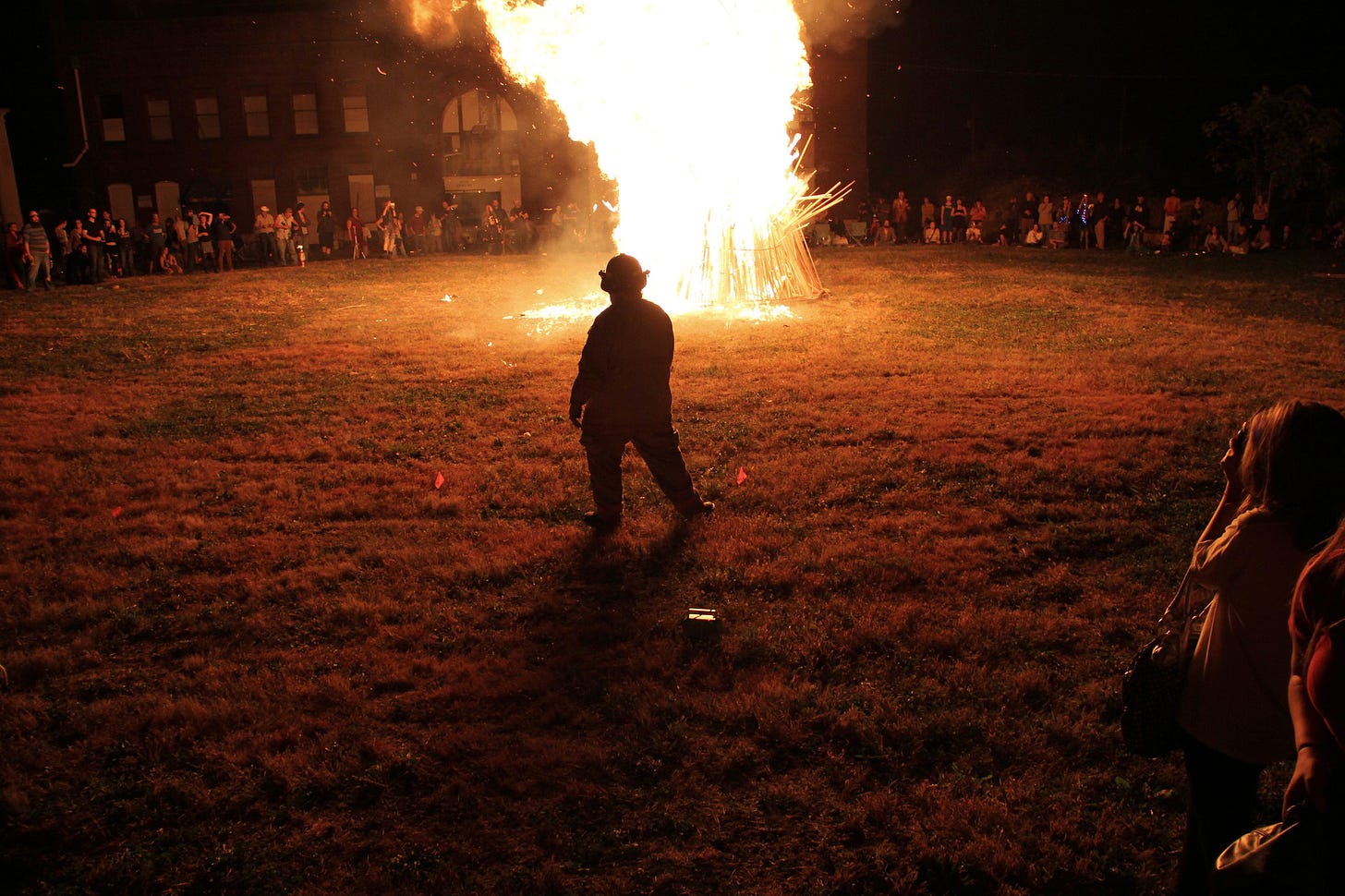This interview was conducted on the second day of Artica 2022, aka October 9, 2022. So comments re: time (“last year,” “this year,” “next year) should be read with that in mind. The curator of this page regrets the gap in time since our original conversation, which took place in the hours before the Burn of Our Lady of Artica at that year’s fest.
Hap was just telling me that he met you when you had a watermelon cut as a pirate ship. Did I hear that correctly?
Yeah, that's right. I met him at the first Artica. The RFT back in the day had a different format. There was a “things happening around town” classifieds. There was a little column with like four lines about “This thing, Artica, is happening. Boat of Dreams is happening. Come display your art. Bring a biodegradable boat to carry your dreams in.” I read the whole thing. This was 2002. I had recently adopted a volunteer role as the regional contact for Burning Man in St. Louis. I had started going to Burning Man in 1999 and thought it was the most amazing, immersive, creative thing I’d ever seen. And I read about Artica and I thought this sounds like the best creative things of Burning Man are happening down the street from me; I have to go. And I made a bio-degradable boat of watermelon, sails made of cornstalks. I balled the watermelon so that people could eat it as we walked. And I flung it into the river where it promptly sank. It flipped over awkwardly and that was it. I had met Hap Phillips that day and Nita Turnage that day and several other amazing people that day.
To your recollection was the first Burn in 2003 or ‘04…?
‘02 was the first year here. And I got as heavily involved as I could immediately after, trying to make the next one happen. I did two projects in 2003. The first one was – having come from Burning Man – wanting to do an effigy burn but trying to do something special, or Artica-specific. In talking with these guys, this concept of Our Lady of Artica came from our spaghetti dinners. This saintly form, this entity was Our Lady of Artica, “which will see us through, our hopes will work out.” And I realized that’s what I needed to make: Our Lady of Artica. This was a combination of an angel, the Virgin Mary and the power tower. Not the larger one; the other one was more visually interesting to burn. That was the smaller project I did that year, actually.
It was a lot rougher down here then. It was a dumping site. With the old railroad, there were remnants lying around. In the rubble pits near the railroad tracks was a janky, abandoned pile of railroad ties and an empty space and then the larger power tower. So I made a tripod out of the railroad ties. The ties themselves were 14-feet long and I got them bolted into twos with lag clips and railroad bolts and spikes. So each leg was like 22-feet long and I hoisted it up into the air.
At that time we were doing BBQs down here regularly, weeks in advance. A week, or two, before Artica it’d all been built and hinged and only needed to be raised. I made a huge fulcrum and used a friend’s giant truck and ran a rope to the center. Leef Armontrout was doing a project in the back and had a Bobcat, a tiny, heavy vehicle with a bucket. I dragged 12 people down. “Everybody help lift these things. We’re going to use this vehicle to hoist a giant tripod that stood at least 15-feet in the air at the fulcrum.” My concept was (taking) this janky pile of railroad ties, turning it into a structure. Next to it was the formal structure of the tower; it was massive. I destroyed the car I was driving with the railroad ties; my old Nissan Stanza blew out second gear dragging them around. It stood for about a year-and-a-half down here.
Actually, if you climbed into the Arch on the City-facing side, (and stood at) the most-rightward facing window and on the little shelf facing the glass… you could just see one leg of it between the buildings. It stood for a year-and-a-half until they leveled some things out down here and it got bulldozed.
At what point in your mind did it not feel like this is a one-off or two-off event, that it had staying power?
The moment when I saw it. The moment I saw it I thought it was vital, important and needed support for forever. It’s the kind of thing… art and creativity are important everywhere. People paint and sculpt and put things on their walls all the time, but this weird manifestation of everyone’s really unique ideas is unlike anything you could put in a gallery. It’s unlike anything you could do at home; it has all this space. You can really scale into different, unique things.
I think it’s fascinating. These are the ideas that everyone had as a kid, when in the woods and digging in the dirt and building stuff; or whatever weird ideas you had with your friends: “wouldn’t it be cool if we did this?” This is where that actually happens. And being able to create that venue, that opportunity on a day-to-day basis for people, I think, is vital. It can’t be a part of your everyday life in many ways, but it’s an extreme event, or opportunity for creativity. Creating that opportunity for people is amazing. I feel that this expression… my hope for Artica is for people to embrace creativity in more pure and extreme ways and incorporate it into the rest of their lives. “If I can do this, what can you do?”
Has there ever been an occasion when someone does (let’s call it) a “guerrilla” performance that’s had to be stopped for whatever reason?
We’ve stopped a couple of things for a couple of different reasons. It’s also the wild, wild west. The event we’re creating and the space can be so dangerous that people forget how dangerous things here are. Artica was pretty lawless for a long time. No insurance, no formal permissions to use properties (sometimes we did, sometimes we were trespassing). It was all ankle-biting with lawsuit possibilities everywhere. It’s a litigious world we live in. The fact that nothing really bad happened is pretty fortunate. So we shut down people doing really stupid things sometimes. We also rely on people making their own best choices. It’s family-friendly in many ways. People bring their kids here, it’s a daytime thing. We had some things be too adult and we had to ask those artists to reel back, or cover it up or stop. But not a lot! I can only think of two instances right now.
There have been spinoff projects and parades – Tiny Totem and Freaquinox – plus Blastoff Bang and other events. What’s your take on the festival weekend vs. things that can and maybe should occur throughout the year?
It’s pushing that idea that you want this amazing creativity in people’s lives all the time. Having the festival as a culmination, or a focus, gives people incentives for something to look forward to; it’s on a calendar and it’s something you can plan around. But keeping a reminder for people is important. Blastoff Bang was a fun name for a straight-up fundraiser. Anytime you do an event, if you have a whole year cycle and people to mix in, what’re the motivations? Money is always a motivation. Community-building, getting volunteers interested to help and produce the thing is a motivator. Drumming up support and artist support, keeping it in their minds. The other events are key to remind people of other, simpler outlets; also good.
We’ve tried to do collaborations. It doesn’t all just have to be down here. We, as collaborators of Artica, have done things for People's Joy Parade, which is another amazing project. The Teeny Tiny Totem was simple and small and kid-focused, where kids (or adults) could make draggable floats. Parades have always been a part of Artica, with the kickoff being the Boat of Dreams Parade, which we talked about earlier. And we keep those alongside all of these other opportunities.
So, balancing all of those motivations is a part of it. In the past, we’ve talked about doing other things, like having a festival event quarterly, or twice a year. Other things like that. I would be all for it, even more regularly. But it takes a lot work and a can take a lot of money. The more money we have available, the more we can pay artists. The less money, the less we can pay artists. Doesn’t mean we can’t do things, but it makes a difference. Also in functionality. We have a good budget this year to pay artists plenty of money, but it also made us able to supply our volunteers with food and coffee and shirts and things that help drum up interest. To be honest, my experience is always that volunteer interest is driven by schwag. Stickers and t-shirts and patches and stuff are always… “where did you get that? Why do you get that? Oh, I have to…” It’s a very powerful thing. People love that stuff. You see a lot of Artica stickers around the city these days.
Two or three last things. You’re in the middle of it, you’re watching this happen right across from us…
The team is loading firewood into the lady right now. And doing it kinda wrong, but that’s okay, that’s okay. It’ll still burn.
With the emotion of this week, for lack of a better term, is there a post-Artica hangover?
Yes. I am having so many fantasies of sitting on my couch with my cats and my wife right now. All I want to do is cook, eat food, sit on the couch and catch up on stupid television and relax. I have a full-time job, I’m not an artist to pay my bills. I have an 8-5 job and I’ve been holding that down. The Our Lady of Artica build is a huge effort, a massive effort. I’ve spent four nights a week after my job doing a half-day, after work, or a full-day on the weekends for a month. And that’s just myself. I have one to five people helping me on every one of those sessions. And I haven't done the math, but it’s hundreds of hundreds of hours of effort to make it all happen. And it’s exhausting. And that’s not even the festival.
I’m the Board President right now and I hold the responsibilities of some executive director and management roles and am treasurer. There’s a lot of other work. Tomorrow is post-, there’s some cleanup. I’ll do a little cleanup and I’ll do some grant writing. We’ll do final reports for grant writing because the sooner we get that money, the sooner we can pay our artists. So that’s gotta get done today and this week. I’m looking forward to that being done, then moving onto the next thing.
And one last thing, in terms of growth. There’s a stage behind us that’s new. Music strikes me as more of a thing over the past few years. Where do you see that moving over the next handful of years?
You know what… here’s the thing that happens with Artica: it’s volunteer-driven and the things that we do are driven by the people that contribute the most. It’s a reflection of that. We’ve had some people on the board that’re helping to make things happen and have connections with musicians and that’s where their interest goes and those are the connections they make. And that’s what happens next. It’s always changing in a lot of ways. And usually it’s growing; the pandemic was very weird to try to analyze growth, though we’ve been getting more formal with our budgeting.
Music’s a thing that’s changed, but that’s due to the contributions of people where that’s their interest. And that’s fantastic. It’s going to always be a manifestation of what people bring. I really like the gritty, weird installation art. That’s where my heart is at. The fact that the space where we have it now is so much park-like than what it is originally… what we used to have is piles of rusty nails. And contractors would dump stuff instead of going to the dump site. Artists would build out of those things and that was really fascinating. We don’t have that anymore, we don’t have materials like that anymore. We have a giant mural in the background, we have access to power from some of the buildings and what’s basically a couple of blank fields to work on. It’s changed because of all that.
And the site. We never know if we’re going to have the site again. We almost lost access this year (ed: 2022). We were confident that we were going to lose access next year (ed: 2023). Actually, I’ve only discussed this with a couple of people: these lots were under contract for sale this year. I contacted the bank two days ago and those contracts fell apart. Our access next year is just as likely as this year and the year before and the year before that. Chances are, we’ll be here next year.
Growth? We’ll see what happens next. What are you going to do at Artica next year?
-30-







